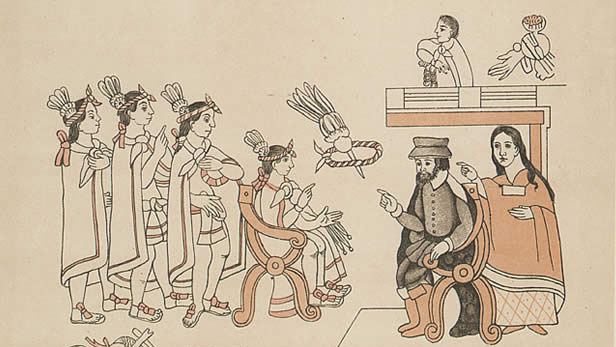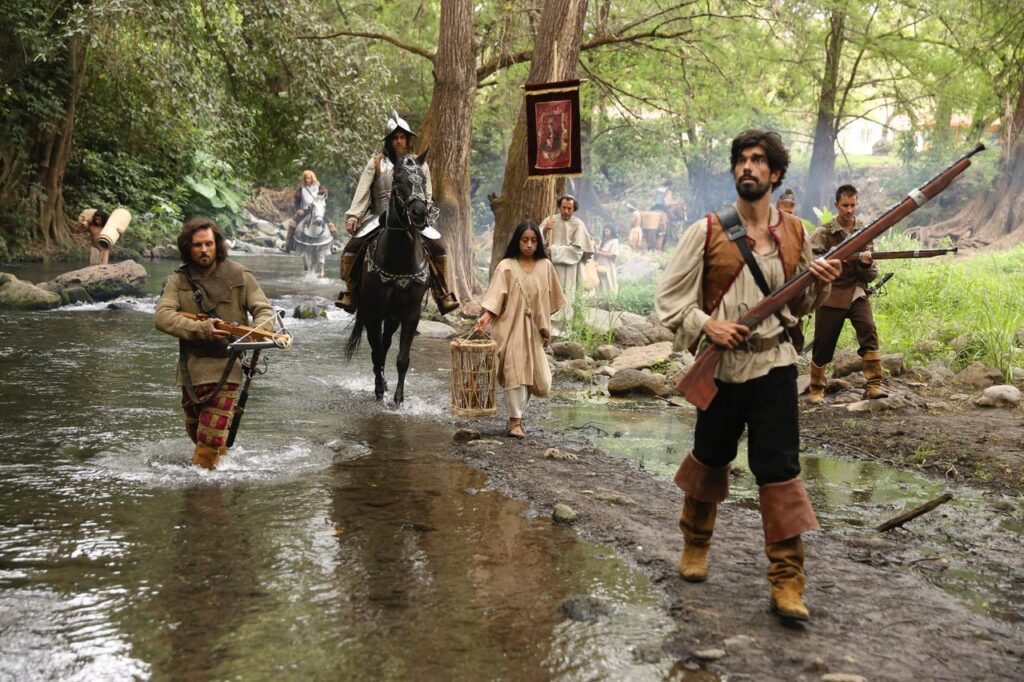One of the most intriguing women in history is an indigenous woman who would become known as La Malinche. Her origins are clouded in a fog of varying details, but generally point to some ideas of who this woman was. Some folks report her birthplace as Olutla (Gomara), others as Tepeticpac (Florentine Codex), or maybe it was Huilotlan (Alva Ixtlilxochitl).
Her actual name is believed to be Malintzin and she seems to be from a town near the coast south of San Juan de Ulua. Most of the tales about her indicate she was at least a noble, if not a full on princess, in a high ranking family in a small town near Cotaxtla. Some accounts say she was sold by her family to support their sagging stake in society. Other tales say she was kidnapped in a raid. By some means she was separated from her family and her town and ended up in a market where she was acquired by the Maya as a slave.
The facts we do have about her are mostly post-contact. The defeated Maya gave her to Cortes after his victory in the Battle of Cintla. As part of the tribute, Malintzin, along with 19 other girls and women, was handed over to the Spaniards. The conquistador Bernal Diaz remembers her as a handsome woman in his account, possessed of grace. It seems she was granted to one of Cortes’s captains as a bride.

But hidden from Cortes was a skill she possessed that would soon reveal itself and become a key to Cortes’s success in Mexico. The expedition left Maya country and arrived in San Juan de Ulua. Cortes and the Spanish first encountered the locals on a beach. These locals spoke the Aztec language of Nahua. Cortes had a Maya translator in his shipwrecked comrade Aguilar, who spent eight years as a captive in the Yucatan. Cortes heard of him and sent a letter, which Aguilar got wind of. The Maya captive made his way to Cozumel and joined Cortes. In the early expedition Aguilar was indispensable translating with Maya nobles and captains in Tabasco. But in Aztec lands he wasn’t as handy.
At some point on that beach Malintzin was noticed, or allowed herself to be noticed, speaking Nahua. She was bilingual, and with Aguilar helped to open communication between Cortes and the Aztecs. When Cortes spoke Aguilar would translate to Maya, and Malintzin would then translate the Maya into Nahua.
As the expedition moved inland, Malintzin learned Spanish, too. Soon she was the only translator needed, and often found herself at the table with power. Every negotiation, every speech about King Charles of Castile, or Mary the Mother of God, every demand for food and treasure, went through Malintzin. It’s hard to imagine that she did not insert her own twists into the language of politics that may have shaped her fortune.

When Cortes and his band of Spanish, Tlaxcala and Totonac warriors, entered Tenochtitlan, Malintzin was at the head of the procession with Cortes. She greeted Moctezuma on behalf of Cortes. This young woman from the coast was now negotiating with the most powerful men in the Empire.
As with most of the women in these tales, Malintzin was involved in relationships with several of the Conquistadors, including Cortes himself. She eventually gave birth to a son named Martin Cortes.
Malintzin was one of the first women in Mexico to be baptized. Shortly after she came into the possession of Cortes she was baptized and given the name Marina. She spent her life from then on, largely at his side, accompanying him to Honduras after the the Fall of Tenochtitlan. According to Diaz, her mother and half-brother were later baptized as Marta and Lazaro.
She is thought to have died around the age of 28, possibly in 1528 or early 1529, just a few years after the fall of Tenochtitlan. Her son, Martin, came to be known as “El Mestizo” and was symbolic of the union between Spain and the Aztec people. This Mestizo concept of shared indigenous and Spanish heritage would later come to be a defining concept for some modern Mexicans.
The legacy of La Malinche in modern Mexico is complicated. She is seen variously as a brave woman who acted with grace and intelligence. On the other hand she is also seen as a betrayer of the Indigenous people, serving the Conqueror Hernan Cortes. As with most powerful and controversial women she is often portrayed as a seductress, a harlot. As if her power came from her sexuality and not her bilingual ability and desire to seize the day.
My opinion is she was an opportunist caught in a very powerful situation and fate delivered her to the cruel, but victorious side. She did what she had to do to thrive. I’m sure she was intelligent, savvy and possibly superficially beautiful. In another sense she seems calculating and cruel but her situation probably demanded such traits. Like all good legends there is just enough to give her form, but enough vapor for the imagination to conjure what it wants.
